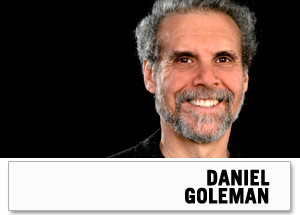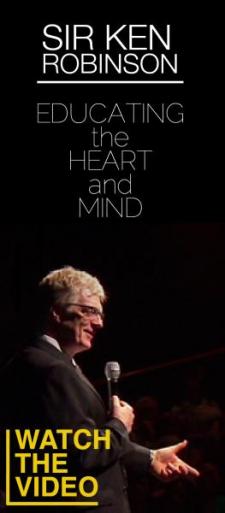Bibliography

Articles
Articles by Daniel Goleman in The New York Times. (1994-2010). Goleman worked at the Times for 12 years and has frequently freelanced for them since then. The link takes you to a listing of his articles from January 2004 to the present day.
Goleman, D. (1998 Nov-Dec). What Makes a Leader? Harvard Business Review. Retrieved June 14, 2010.
'“Effective leaders possess a high degree of emotional intelligence. Along with IQ and technical skills, emotional capabilities are the entry-level requirements for executive positions. Emotional intelligence is playing an important role at the highest levels of the company and is often linked to exceptional performance. Social skill is another key component to successful management.”
Goleman, D. (2000 Mar-Apr). Leadership That Gets Results. Harvard Business Review. Retrieved June 14, 2010.
“The most successful executives use a collection of distinct leadership styles—each in the right measure, at just the right time. Such flexibility is tough to put into action, but it pays off in performance. And better yet, it can be learned.”
Goleman, D., & Norris, G. (2010 Apr). How Green Is My iPad? New York Times. Retrieved June 14, 2010.
Goleman and Norris discuss the question, Which is more environmentally friendly: an e-reader or an old-fashioned book?
Books
Boyatzis, R., Goleman, D., & McKee, A. (2002). Primal Leadership: Realizing the Power of Emotional Intelligence. Boston: Harvard Business School Press.
Goleman and his co-authors present the case for cultivating emotionally intelligent leaders. Since the actions of the leader apparently account for up to 70% of employees’ perception of the climate of their organization, Goleman and his team emphasize the importance of developing what they term “resonant leadership.” Focusing on the four domains of emotional intelligence—self-awareness, self-management, social awareness, and relationship management—they explore what contributes to and detracts from resonant leadership and how the development of these four EI competencies spawns different leadership styles.
Cherniss, C., & Goleman, D. (Eds.). (2001). The Emotionally Intelligent Workplace: How to Select For, Measure, and Improve Emotional Intelligence in Individuals, Groups, and Organizations. San Francisco: Jossey-Bass.
How does emotional intelligence as a competency go beyond the individual to become something a group or entire organization can build and utilize collectively? Written primarily by members of the Consortium for Research on Emotional Intelligence in Organizations, founded by recognized EI experts Daniel Goleman and Cary Cherniss, this groundbreaking compendium examines the conceptual and strategic issues involved in defining, measuring, and promoting emotional intelligence in organizations. The book’s contributing authors share 15 models that have been field-tested and empirically validated in existing organizations. They also detail 22 guidelines for promoting emotional intelligence and outline a variety of measurement strategies for assessing emotional and social competence in organizations.
Goleman, D. (1985). Vital Lies, Simple Truths: The Psychology of Self Deception. New York: Simon & Schuster.
A penetrating analysis of the ways we deceive ourselves. Daniel Goleman draws on evidence of all kinds to reveal how we skew our most intimate relationships, our day-to-day lives, and our common reality, by burying painful insights and memories. This important book both illuminates and raises challenging questions about a subject that is central to our psychological existence.
Goleman, D. (1988). The Meditative Mind. New York: G. P. Putnam’s Sons.
A traveller’s guide to the topography of the spirit for every spiritual seeker. For the beginning meditator, the book provides a comprehensive, accessible overview of the different kinds of meditation and introduces the reader to the basic elements of their practice. For the experienced meditator, Goleman explores the distinct levels of consciousness developed as a result of long-term application.
Goleman, D. (1996). Emotional Intelligence: Why It Can Matter More Than IQ. New York: Bantam Books.
Goleman argues that our emotions play a much greater role in thought, decision making, and individual success than is commonly acknowledged. He defines “emotional intelligence”—a trait not measured by IQ tests—as a set of skills, including control of one’s impulses, self-motivation, empathy, and social competence in interpersonal relationships. This report is an intriguing and practical guide to emotional mastery. Goleman looks at pilot programs in schools from New York City to Oakland, CA, where children are taught conflict resolution, impulse control, and social skills.
Goleman, D. (Ed.). (1997). Healing Emotions: Conversations with the Dalai Lama on Mindfulness, Emotions, and Health. Boston: Shambhala Publications, Inc.
Can the mind heal the body? The Buddhist tradition says yes, and now many Western scientists are beginning to agree. Healing Emotions is the record of an extraordinary series of encounters between the Dalai Lama and prominent western psychologists, physicians, and meditation teachers. It sheds new light on the mind-body connection. Topics include: compassion as medicine; the nature of consciousness; self-esteem; and the meeting points of mind, body, and spirit.
Goleman, D. (1998). Working With Emotional Intelligence. New York: Bantam Books.
Goleman takes the concepts from his bestseller, Emotional Intelligence, into the workplace. This book explains what emotional intelligence is and why it counts more than IQ or expertise for excelling on the job. It details 12 personal competencies based on self-mastery and 13 key relationship skills. Goleman includes many examples and anecdotes—from Fortune 500 companies to a non-profit preschool—that show how these competencies lead to or thwart success.
Goleman, D. (2003). Destructive Emotions: How Can We Overcome Them? A Scientific Dialogue With the Dalai Lama. New York: Bantam Dell.
This book puts to rest the misconception that the realms of science and spirituality are at odds. Goleman presents dialogues between the Dalai Lama and a small group of eminent psychologists, neuroscientists, and philosophers, who probe several challenging questions. Varied perspectives of science, philosophy, and eastern and western thought beautifully illustrate the symbiosis among the views, which are readily entire five-day seminar or choose sections that are most relevant to their interests. The real joy is in gaining an insider’s view of these extraordinary minds at work, especially that of the Dalai Lama, whose curiosity, Socratic questioning, and humour ultimately serve as the linchpin for the book’s soaring intellectual discussion.
Goleman, D. (2006). Social Intelligence: The New Science of Social Relationships. New York: Bantam Dell.
A groundbreaking synthesis of the latest findings in biology and brain science, revealing that we are “wired to connect” and the surprisingly deep impact of our relationships on every aspect of our lives.
Goleman, D., & Lantieri, L. (2008). Building Emotional Intelligence: Techniques to Cultivate Inner Strength in Children [With CD]. Boulder, CO: Sounds True, Inc.
A breakthrough guide for helping children quiet their minds, calm their bodies, and identify and manage their emotions. Lantieri’s proven techniques are arranged according to age group and complemented by a spoken-word CD with exercises presented by Goleman. “We need a new vision of education that includes the mind and the heart,” says Lantieri. With Building Emotional Intelligence, parents, teachers, and caregivers have the tools necessary to help build these invaluable skills in the children they raise.
Goleman, D. (2009). Ecological Intelligence: How Knowing the Hidden Impacts of What We Buy Can Change Everything. New York: Broadway Books.
Daniel Goleman reveals the hidden environmental consequences of what we make and buy and shows how new market forces can drive the essential changes we all must make to save our planet. Ecological Intelligence draws on cutting-edge research to reveal why “green is a mirage,” illuminates inconsistencies in our response to the ecological crisis, and introduces new technologies that reveal with “radical transparency” the eco-impact of products we buy, with the potential to drive consumers to make smarter decisions and companies to reform their business practices.





